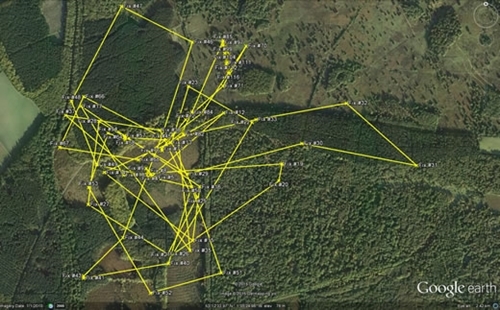by Chris Heward, GWCT Wetlands Research Assistant
We can only begin to explain changes in a species’ abundance if we possess a basic understanding of its behaviour and ecology. In the case of the woodcock, however, it is unsurprising that there are many areas in which our current knowledge is lacking.
Given recent declines in the size of Britain’s resident woodcock population, it is more important than ever that we understand the breeding biology of this woodland bird.
Harnessing new tracking technology
New tracking technology is allowing us to do this in a way that has never previously been possible. This summer I started catching breeding resident woodcock and fitting them with small GPS tracking devices.
 At dusk, male woodcock fly large ‘roding’ circuits in order to attract the attention of a female. This aerial photograph shows the movements of a tagged woodcock doing just this. By knowing the average area and duration of these conspicuous displays we can better interpret the results of our national Breeding Woodcock Survey which use counts of roding males to estimate abundance.
At dusk, male woodcock fly large ‘roding’ circuits in order to attract the attention of a female. This aerial photograph shows the movements of a tagged woodcock doing just this. By knowing the average area and duration of these conspicuous displays we can better interpret the results of our national Breeding Woodcock Survey which use counts of roding males to estimate abundance.
These tags differ from the satellite-transmitters we use to study migration in that they have a much shorter lifespan – but in that time take more accurate, finer-scale data.
Whilst satellite tags are perfect for tracking large scale migrations across continents these new GPS loggers are much better at following the more localised movements of our resident birds during the breeding season.
What data from the new study is telling us
Such a high degree of accuracy is key to this new study as it allows us to distinguish the specific types of woodland habitats that are utilised. For example, data gathered this year are beginning to show a preference for woodland with dense understory; this provides woodcock with cover during nesting and roosting.
Dense vegetation also plays a role in keeping soils moist, which is an important consideration for a bird that feeds by probing soil and leaf litter. At night, however, particularly after showers, male woodcock will visit clearings in woodland to feed, so the availability of open areas within woodland may also be important.
These clearings also play a role in the courtship display of the males. The fact that woodcock need both densely-vegetated and open habitats within their home ranges highlights the need for woodland with a diverse and multi-aged structure.
We are also using these tags to gain a better understanding of the male’s roding display. Because our national Breeding Woodcock Survey uses counts of roding males to assess woodcock abundance, it is important that we fully understand this display behaviour in order to be able to interpret the results correctly.
GPS loggers are allowing us to measure how large an area males cover when roding, how many circuits they fly per evening and whether they rode every night. These details will enable us to improve the reliability of our population estimates.
It will also allow us to see how the size and distribution of woodland within the landscape affects courtship behaviour and whether these displays are dependent upon specific habitat features.
Looking ahead to 2016
This work is still in its infancy, but I am encouraged by the successful season we have had in 2015 and looking forward to continuing this study in 2016. The data gathered by these tags, as well as continued analysis of the national survey results, will provide much needed information on our often overlooked resident woodcock.
This improved understanding could in turn inform guidelines for woodland management, ensuring woodlands are well-suited to the woodcock that depend on them.
A quick thank you
The fieldwork for this project was only possible thanks to the efforts of volunteers from the Birklands Ringing Group.
Please support our vital woodcock work